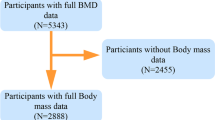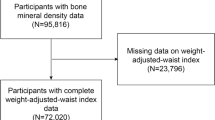Abstract
Summary
The obesity-BMD relationship is complex. In 3045 middle-aged adults, we found that in women (but not men) with discordant fat mass index (FMI)/BMI categories, higher body fat for BMI was associated with lower BMD, suggesting that increased fat mass without an accompanying increase in lean mass may be deleterious to bone.
Introduction
The relationship between obesity and BMD is complex. FMI (fat mass (kg) / height (m)2) is a more accurate measure of fatness than BMI, and depending on body composition, some individuals have discordant BMI/FMI categories. We examined associations between FMI, BMI and BMD in participants in the Busselton Healthy Ageing Study.
Methods
Body composition and BMD of the hip, spine and total body were measured using DXA in 3045 participants (1644 females) aged 45–67 years. Using standard BMI/FMI categories, the participants were classified as underweight/fat deficit, normal, overweight/excess fat, obese I and obese II–III.
Results
BMI and FMI categories were concordant in 77.3 % of females and 71.2 % of males. There were 12.9 % females and 13.2 % males in a higher FMI than BMI category (high body fat for BMI), whereas 9.8 % females and 15.6 % males were in a lower category (low body fat for BMI). Females with high body fat for BMI had significantly lower covariate-adjusted BMD at the femoral neck, total hip and total body (differences of 3.8, 5.1 and 2.6 %, respectively, all P < 0.05) than females with low body fat for BMI and lower total body BMD than women with concordant FMI/BMI (by 1.4 %, P = 0.04). In males, BMD did not differ significantly between those who were concordant or discordant for FMI/BMI categories.
Conclusion
In women (but not men) with discordant FMI/BMI categories, higher body fat for BMI was associated with lower BMD, suggesting that increased fat mass without an accompanying increase in lean mass may be deleterious to bone.


Similar content being viewed by others
References
Felson DT, Zhang Y, Hannan MT, Anderson JJ (1993) Effects of weight and body mass index on bone mineral density in men and women: the Framingham study. J Bone Miner Res 8:567–573
Lloyd JT, Alley DE, Hawkes WG, Hochberg MC, Waldstein SR, Orwig DL (2014) Body mass index is positively associated with bone mineral density in US older adults. Arch Osteoporos 9:175
Zhao LJ, Jiang H, Papasian CJ, Maulik D, Drees B, Hamilton J, Deng HW (2008) Correlation of obesity and osteoporosis: effect of fat mass on the determination of osteoporosis. J Bone Miner Res 23:17–29
Cao JJ (2011) Effects of obesity on bone metabolism. J Orthop Surg Res 6:30
Prieto-Alhambra D, Premaor MO, Fina Aviles F, Hermosilla E, Martinez-Laguna D, Carbonell-Abella C, Nogues X, Compston JE, Diez-Perez A (2012) The association between fracture and obesity is site-dependent: a population-based study in postmenopausal women. J Bone Miner Res 27:294–300
Gjesdal CG, Halse JI, Eide GE, Brun JG, Tell GS (2008) Impact of lean mass and fat mass on bone mineral density: the Hordaland Health Study. Maturitas 59:191–200
Bachmann KN, Bruno AG, Bredella MA et al (2016) Vertebral strength and estimated fracture risk across the BMI spectrum in women. J Bone Miner Res 31:281–288
Douchi T, Kuwahata R, Matsuo T, Uto H, Oki T, Nagata Y (2003) Relative contribution of lean and fat mass component to bone mineral density in males. J Bone Miner Metab 21:17–21
Douchi T, Matsuo T, Uto H, Kuwahata T, Oki T, Nagata Y (2003) Lean body mass and bone mineral density in physically exercising postmenopausal women. Maturitas 45:185–190
Liu JM, Zhao HY, Ning G, Zhao YJ, Zhang LZ, Sun LH, Xu MY, Chen JL (2004) Relationship between body composition and bone mineral density in healthy young and premenopausal Chinese women. Osteoporos Int 15:238–242
Reid IR, Evans MC, Ames RW (1994) Volumetric bone density of the lumbar spine is related to fat mass but not lean mass in normal postmenopausal women. Osteoporos Int 4:362–367
Reid IR, Ames R, Evans MC, Sharpe S, Gamble G, France JT, Lim TM, Cundy TF (1992) Determinants of total body and regional bone mineral density in normal postmenopausal women—a key role for fat mass. J Clin Endocrinol Metab 75:45–51
Gnudi S, Sitta E, Fiumi N (2007) Relationship between body composition and bone mineral density in women with and without osteoporosis: relative contribution of lean and fat mass. J Bone Miner Metab 25:326–332
Ijuin M, Douchi T, Matsuo T, Yamamoto S, Uto H, Nagata Y (2002) Difference in the effects of body composition on bone mineral density between pre- and postmenopausal women. Maturitas 43:239–244
Zhu K, Briffa K, Smith A, Mountain J, Briggs AM, Lye S, Pennell C, Straker L, Walsh JP (2014) Gender differences in the relationships between lean body mass, fat mass and peak bone mass in young adults. Osteoporos Int 25:1563–1570
Kelly TL, Wilson KE, Heymsfield SB (2009) Dual energy X-ray absorptiometry body composition reference values from NHANES. PLoS ONE 4:e7038
Gallagher D, Heymsfield SB, Heo M, Jebb SA, Murgatroyd PR, Sakamoto Y (2000) Healthy percentage body fat ranges: an approach for developing guidelines based on body mass index. Am J Clin Nutr 72:694–701
Zhu K, Hunter M, James A, Lim EM, Walsh JP (2015) Associations between body mass index, lean and fat body mass and bone mineral density in middle-aged Australians: the Busselton Healthy Ageing Study. Bone 74:146–152
James A, Hunter M, Straker L et al (2013) Rationale, design and methods for a community-based study of clustering and cumulative effects of chronic disease processes and their effects on ageing: the Busselton Healthy Ageing Study. BMC Public Health 13:936
WHO (2000) Obesity: preventing and managing the global epidemic. Report of a WHO Consultation. WHO Technical Report Series 894. World Health Organization, Geneva
IPAQ http://www.ipaq.ki.se/scoring.htm. Accessed 21 Dec 2014
Cooke DJ, Cooke B, Bell D, Vasikaran S, Glendenning P (2015) ANNALS EXPRESS: C-3-epi-25-hydroxyvitamin D is universally present in neonatal Western Australian samples but is unlikely to contribute to diagnostic misclassification. Ann Clin Biochem. doi:10.1177/0004563215625693
Hsu YH, Venners SA, Terwedow HA et al (2006) Relation of body composition, fat mass, and serum lipids to osteoporotic fractures and bone mineral density in Chinese men and women. Am J Clin Nutr 83:146–154
Compston JE, Watts NB, Chapurlat R et al (2011) Obesity is not protective against fracture in postmenopausal women: GLOW. Am J Med 124:1043–1050
Tang ZH, Xiao P, Lei SF et al (2007) A bivariate whole-genome linkage scan suggests several shared genomic regions for obesity and osteoporosis. J Clin Endocrinol Metab 92:2751–2757
David V, Martin A, Lafage-Proust MH, Malaval L, Peyroche S, Jones DB, Vico L, Guignandon A (2007) Mechanical loading down-regulates peroxisome proliferator-activated receptor gamma in bone marrow stromal cells and favors osteoblastogenesis at the expense of adipogenesis. Endocrinology 148:2553–2562
Colaianni G, Brunetti G, Faienza MF, Colucci S, Grano M (2014) Osteoporosis and obesity: role of Wnt pathway in human and murine models. World J Orthop 5:242–246
Braun T, Schett G (2012) Pathways for bone loss in inflammatory disease. Curr Osteoporos Rep 10:101–108
Bredella MA, Torriani M, Ghomi RH, Thomas BJ, Brick DJ, Gerweck AV, Harrington LM, Breggia A, Rosen CJ, Miller KK (2011) Determinants of bone mineral density in obese premenopausal women. Bone 48:748–754
Bolland MJ, Grey AB, Ames RW, Mason BH, Horne AM, Gamble GD, Reid IR (2006) Determinants of vitamin D status in older men living in a subtropical climate. Osteoporos Int 17:1742–1748
Bolland MJ, Grey AB, Ames RW, Horne AM, Gamble GD, Reid IR (2006) Fat mass is an important predictor of parathyroid hormone levels in postmenopausal women. Bone 38:317–321
Riggs BL (2000) The mechanisms of estrogen regulation of bone resorption. J Clin Invest 106:1203–1204
St-Onge MP (2005) Relationship between body composition changes and changes in physical function and metabolic risk factors in aging. Curr Opin Clin Nutr Metab Care 8:523–528
Baumgartner RN (2000) Body composition in healthy aging. Ann N Y Acad Sci 904:437–448
Ilich JZ, Inglis JE, Kelly OJ, McGee DL (2015) Osteosarcopenic obesity is associated with reduced handgrip strength, walking abilities, and balance in postmenopausal women. Osteoporos Int 26:2587–2595
Cermak NM, Res PT, de Groot LC, Saris WH, van Loon LJ (2012) Protein supplementation augments the adaptive response of skeletal muscle to resistance-type exercise training: a meta-analysis. Am J Clin Nutr 96:1454–1464
Reid IR (2010) Fat and bone. Arch Biochem Biophys 503:20–27
Dimitri P, Bishop N, Walsh JS, Eastell R (2012) Obesity is a risk factor for fracture in children but is protective against fracture in adults: a paradox. Bone 50:457–466
Flegal KM, Carroll MD, Kit BK, Ogden CL (2012) Prevalence of obesity and trends in the distribution of body mass index among US adults, 1999-2010. JAMA 307:491–497
Australian Bureau of Statistics. ABS 4364.0.55.001—Australian Health Survey: first results, 2011-12. http://www.abs.gov.au/AUSSTATS/abs@.nsf/DetailsPage/4364.0.55.0012011-12?OpenDocument. Accessed 20 Apr 2016
Yu EW, Thomas BJ, Brown JK, Finkelstein JS (2012) Simulated increases in body fat and errors in bone mineral density measurements by DXA and QCT. J Bone Miner Res 27:119–124
Acknowledgments
We thank the Western Australian Country Health Service South West for the core infrastructure support; the operational team in Busselton of Elspeth Inglis, Aida Embling, Darcy Bennett, Shelley Cheetham, Jessica Storey, Debra Burwood, Dianne Toovey, Stephanie Murphy and Jenifer George for the participant recruitment and data collection; and the community of Busselton for their ongoing support and participation. We thank BD Biosciences for donating blood collection kits and Abbott Australasia Pty Ltd. for donating assay kits for 25-OH vitamin D.
Author information
Authors and Affiliations
Corresponding author
Ethics declarations
Funding support
The baseline survey of the Busselton Healthy Ageing Study was funded by grants from the Office of Science and Department of Health of the Government of Western Australia, the City of Busselton, a bequest of the late Dr. Janet Elder and private donors. The DXA machine was funded by a NHMRC equipment grant. None of the funding agencies had any role in the conduct of the study; collection, management, analysis or interpretation of the data; or preparation, review or approval of the manuscript.
Conflicts of interest
None.
Rights and permissions
About this article
Cite this article
Zhu, K., Hunter, M., James, A. et al. Discordance between fat mass index and body mass index is associated with reduced bone mineral density in women but not in men: the Busselton Healthy Ageing Study. Osteoporos Int 28, 259–268 (2017). https://doi.org/10.1007/s00198-016-3710-8
Received:
Accepted:
Published:
Issue Date:
DOI: https://doi.org/10.1007/s00198-016-3710-8




